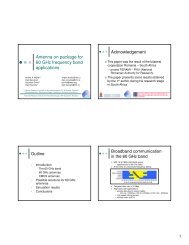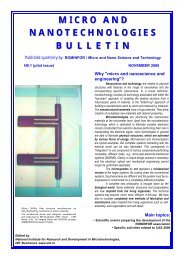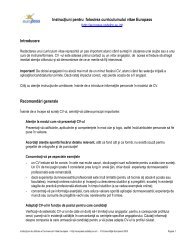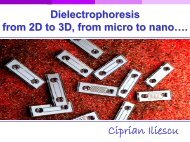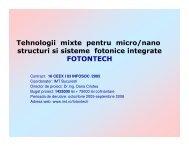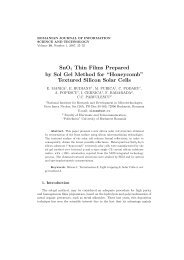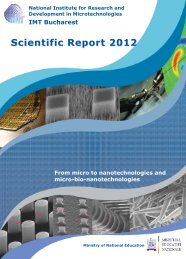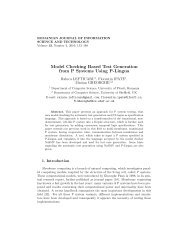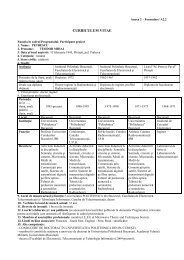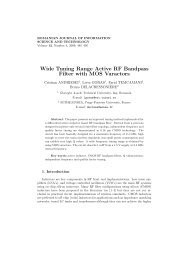Ka-Band RF MEMS Phase Shifters for Energy Starved ... - IMT
Ka-Band RF MEMS Phase Shifters for Energy Starved ... - IMT
Ka-Band RF MEMS Phase Shifters for Energy Starved ... - IMT
- No tags were found...
You also want an ePaper? Increase the reach of your titles
YUMPU automatically turns print PDFs into web optimized ePapers that Google loves.
<strong>Ka</strong>-<strong>Band</strong> <strong>RF</strong> <strong>MEMS</strong> <strong>Phase</strong> <strong>Shifters</strong> <strong>for</strong><strong>Energy</strong> <strong>Starved</strong> Millimetre-WaveRadar SensorsOutline• Introduction- Background, target application (low-power multifunctional radar sensor)• <strong>Ka</strong>-band <strong>RF</strong> <strong>MEMS</strong> phase shifters made on quartz- Loaded line and switched line phase shifter circuitsR. Malmqvist 1,2 , C. Samuelsson 1 , B. Carlegrim 1 , Rantakari 3 , T. Vähä-Heikkilä 3 , A. Rydberg 2 and J. Varis 31 FOI, Swedish Defence Research Agency, Linköping, Sweden2 Uppsala University, Uppsala University, Sweden3 VTT, Technical research centre of Finland, Espoo, Finland• System level impact of using low-loss <strong>RF</strong> <strong>MEMS</strong> phase shifters- <strong>Phase</strong>d array front-end architectures (AESA/PESA)2010 Int. Semiconductor Conference (CAS2010), Sinaia, Romania, Oct. 11-13, 2010• Conclusion- SummaryNovember 18, 2010November 18, 20102R. MalmqvistFOI Swedish Defence Research AgencyR. MalmqvistFOI Swedish Defence Research Agency<strong>Energy</strong> starved mm-wave radar sensors<strong>RF</strong> <strong>MEMS</strong> phased arrays (MOSART project)• <strong>MEMS</strong> based reconfigurable<strong>RF</strong> systems <strong>for</strong> softwareradio, wireless sensors, andMMID technology (MOSARTproject)• Funded and supportedwithin the NORDITE program(Sweden, Finland, Norway)• Adaptive <strong>RF</strong> front-ends(incl. low-loss phased arrays)using <strong>RF</strong> <strong>MEMS</strong> and LTCCbased technologies• Project time: 2008-2010• Increasingly important to achieve low cost, size, weight and DC power <strong>for</strong> the radar hardware onsmall sensor plat<strong>for</strong>ms such as UAVs. The passive electronically scanned array (PESA) antennaarchitecture may <strong>for</strong> certain applications result in compact, power-efficient and af<strong>for</strong>dable systems• Compared with using COTS, a use of multi-bit phase shifters realised using <strong>RF</strong> <strong>MEMS</strong> technologycould result in significantly improved <strong>RF</strong> properties at microwave/millimetre-wave frequencies• Prototypes of 35 GHz active phased array modules (PESA front-end architecture using low-loss <strong>RF</strong> <strong>MEMS</strong>phase shifters, LNA together with antennas and feed networks made on LTCC) have been realised within theMOSART project carried out by the research partners VTT, Uppsala University and FOI• An <strong>RF</strong> <strong>MEMS</strong> loaded line phase shifter circuit with 3.5 dB of average loss @ 35 GHz were used (VTT design)• Various phase shifter circuits implemented on quartz using a capacitive <strong>RF</strong> <strong>MEMS</strong> switch process at VTTNovember 18, 20103November 18, 20104R. MalmqvistFOI Swedish Defence Research AgencyR. MalmqvistFOI Swedish Defence Research Agency1
<strong>RF</strong> <strong>MEMS</strong> phase shifter (quartz)35 GHz loaded line phase shifters (22.5°and 45°bits)<strong>RF</strong> <strong>MEMS</strong> phase shifter (quartz)35 GHz loaded line phase shifters (22.5°and 45°bits)1-switch phase shifter (22.5°bit)2-switch phase shifter (45°bit)0.3 mm 2 1.3 mm 2• 1-switch phase shifter circuit a relative phase shift of 22°@ 35 GHz (22° simulated)• 2-switch phase shifter circuit a relative phase shift of 38° @ 35 GHz (45° simulated)• 1-switch phase shifter circuit (22.5° bit) 0.4 dB of insertion loss @ 35 GHz (0.2-0.3 dB simulated)• 2-switch phase shifter circuit (45° bit) 0.5-0.9 dB of insertion losses @ 35 GHz (0.4-0.7 dB sim.)November 18, 20105November 18, 20106R. MalmqvistFOI Swedish Defence Research AgencyR. MalmqvistFOI Swedish Defence Research Agency<strong>RF</strong> <strong>MEMS</strong> phase shifter (quartz)<strong>RF</strong> <strong>MEMS</strong> phase shifter (quartz)35 GHz switched line phase shifters (180°bit and 3-bit)35 GHz switched line phase shifter (180°bit)1-bit switched line phase shifter (180°bit)3-bit switched line phase shifter (45°+ 90°+ 180°)28 mm 2 89 mm 2• 1-bit and 3-bit <strong>RF</strong> <strong>MEMS</strong> phase shifter circuits implemented using switched line (SL) topologies• SL phase shifter functionality will depend on that all the <strong>RF</strong> <strong>MEMS</strong> switches used are functioning as intended• 1.2-1.5 dB of insertion loss and 187° dB of relative phase shift @ 30 GHz FoM = 122°/dB• Discrepancies may be explained by a higher capacitive loading <strong>for</strong> the air bridges used in this designNovember 18, 20107November 18, 2010R. MalmqvistFOI Swedish Defence Research AgencyR. MalmqvistFOI Swedish Defence Research Agency2
<strong>RF</strong> <strong>MEMS</strong> phase shifters resultsMeasured and estimated data (summary)<strong>RF</strong> <strong>MEMS</strong> phase shifter (GaAs MMIC)24 GHz (1-bit) switched-line phase shifter (180°)<strong>Phase</strong> shifter -stateLoss(22° bit)Loss(45° bit)Loss(180° bit)Loss(3-bit)Loss(5-bit)3 mm 2Min(ref.)0.4 dB @ 35 GHz(0.2 dB sim.)0.5 dB @ 35 GHz(0.4 dB sim.)1.2 dB @ 30 GHz(0.6 dB sim.)2.1 (est.)3.5 (est.)Max(delay)0.4 dB @ 35 GHz(0.3 dB sim.)0.9 dB @ 35 GHz(0.7 dB sim.)1.5 dB @ 30 GHz(1.1 dB sim.)2.8 (est.)4.5 (est.)Average0.4 dB @ 35 GHz(0.3 dB sim.)0.7 dB @ 35 GHz(0.6 dB sim.)1.4 dB @ 30 GHz(0.9 dB sim.)2.5 (est.)4.0 (est.)• <strong>Phase</strong> shifter bits (22.5°, 45° and 180°) realized with 0.4 dB, 0.7 dB and 1.4 dB of average losses, respectively• 3-bit and 5-bit <strong>MEMS</strong> phase shifter circuits are estimated with average losses of 2.5 dB and 4 dB, respectively• 1.2-2.3 dB of insertion loss (1.8 dB average) and 180° dB of relative phase shift @ 23 GHz• A relatively good agreement was found in this case between measured and simulated resultsNovember 18, 20109November 18, 201010R. MalmqvistFOI Swedish Defence Research AgencyR. MalmqvistFOI Swedish Defence Research Agency<strong>RF</strong> <strong>MEMS</strong> phase shifter (GaAs MMIC)35 GHz (3-bit) switched-line phase shifter (315°)Impact of using <strong>RF</strong> <strong>MEMS</strong> phase shiftersSystem requirements (<strong>Ka</strong>-band multifunctional radar system)7 mm 2 12Ku-band con<strong>for</strong>mal array antennaaperture developed at FOI(L. Pettersson et al., 5th Europ.Workshop on Con<strong>for</strong>mal Antennas,Bristol, UK, Sept. 2007)• Con<strong>for</strong>mal antennas may be integrated in the fuselage of a small sensor plat<strong>for</strong>m such as e.g. an UAV• 3.7-5.8 dB of insertion loss (<strong>for</strong> the 000 and 110 states) and 270° dB of relative phase shift @ 29.5 GHz• A µ-strip based <strong>MEMS</strong>-MMIC 3-bit phase shifter design has 3 dB of simulated average loss @ 35 GHz• Critical aspects w.r.t. feasible sensor hardware cost, weight and DC power (max 50 W <strong>for</strong> the radar: <strong>RF</strong> & Dig.)• A use of a PESA front-end architecture on the Rx side (e.g. 1:8) can drastically reduce the no. LNAs neededNovember 18, 201011November 18, 2010R. MalmqvistFOI Swedish Defence Research AgencyR. MalmqvistFOI Swedish Defence Research Agency3
Impact of using <strong>RF</strong> <strong>MEMS</strong> phase shiftersSystem analysis (See-and-Avoid Radar)Impact of using <strong>RF</strong> <strong>MEMS</strong> phase shiftersSystem analysis (Synthetic Aperture Radar)<strong>Phase</strong> shifter loss (@ <strong>Ka</strong>-band)(Technology)7 dB (5 bit)(COTS) [11]4 dB (5 bit)(Estimated) [17]2 dB (3 bit)(<strong>RF</strong> <strong>MEMS</strong>) [10]DC power consumption (P DC ) - Tx33 W17 W10 W• Estimated required P dc (Tx) <strong>for</strong> a See-and-Avoid (PESA Rx) phased array radar sensor in heavy rain whenassuming different phase shifter losses (assuming also 2 dB of feed network losses) – 5.5 km of R detection• Low phase shifter losses (2-4 dB) needed <strong>for</strong> all-weather radar capability (max 20-25 W of P dc )• Estimated values of required P dc (Tx) <strong>for</strong> a <strong>Ka</strong>-band multifunctional SAR sensor (using a PESA Rx front-end)• Low-loss <strong>MEMS</strong> phase shifters may reduce P dc (Tx) with a factor 2-3 (compared with using COTS)November 18, 201013November 18, 201014R. MalmqvistFOI Swedish Defence Research AgencyR. MalmqvistFOI Swedish Defence Research AgencyConclusionsAcknowledgements• We have presented an assessment study of fabricated millimetre-wave <strong>RF</strong> <strong>MEMS</strong> phase shifters<strong>for</strong> a <strong>Ka</strong>-band low-power (energy starved) multifunctional radar sensor application• Two loaded line phase shifter bits result in a phase shift of 22.3° and 38° together with 0.4 d<strong>Band</strong> 0.9 dB of losses @ 35 GHz, respectively. A switched line phase shifter achieve 187° of phaseshift and 1.5 dB of loss @ 30 GHz (corresponding to FoM = 122°/dB)• The realised <strong>RF</strong> <strong>MEMS</strong> phase shifter circuits may be used to implement low-loss multi-bit (e.g.3-bit and 5-bit) phase shifters <strong>for</strong> certain mm-wave applications• VINNOVA and TEKES (in Sweden and Finland, respectively) <strong>for</strong> the funding andcontinuous support of the NORDITE project MOSART• European Union <strong>for</strong> the funding and continuous support of the FP7 ICT project<strong>MEMS</strong>-4-MMIC• The work was carried out in the framework of COST Action IC0803 -<strong>RF</strong>/Microwave Communication Subsystems <strong>for</strong> Emerging Wireless Technologies• We estimate that a use of such high per<strong>for</strong>mance <strong>RF</strong> <strong>MEMS</strong> phase shifters can reduce by afactor 2-3 the required transmit DC power level in a <strong>Ka</strong>-band phased array radar systemNovember 18, 201015November 18, 201016R. MalmqvistFOI Swedish Defence Research AgencyR. MalmqvistFOI Swedish Defence Research Agency4



